Yifeng Yu
SingMOS-Pro: An Comprehensive Benchmark for Singing Quality Assessment
Oct 02, 2025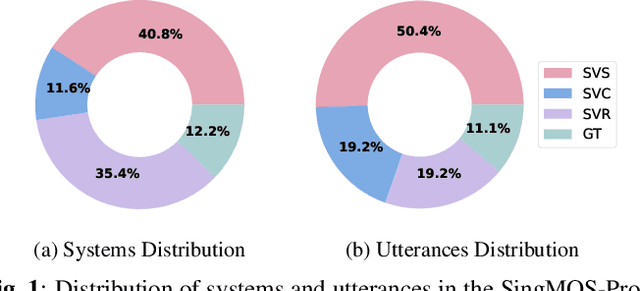

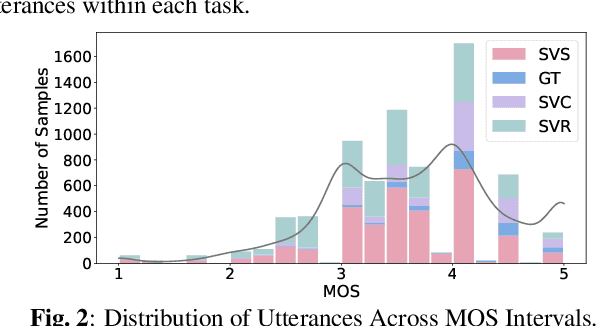

Abstract:Singing voice generation progresses rapidly, yet evaluating singing quality remains a critical challenge. Human subjective assessment, typically in the form of listening tests, is costly and time consuming, while existing objective metrics capture only limited perceptual aspects. In this work, we introduce SingMOS-Pro, a dataset for automatic singing quality assessment. Building on our preview version SingMOS, which provides only overall ratings, SingMOS-Pro expands annotations of the additional part to include lyrics, melody, and overall quality, offering broader coverage and greater diversity. The dataset contains 7,981 singing clips generated by 41 models across 12 datasets, spanning from early systems to recent advances. Each clip receives at least five ratings from professional annotators, ensuring reliability and consistency. Furthermore, we explore how to effectively utilize MOS data annotated under different standards and benchmark several widely used evaluation methods from related tasks on SingMOS-Pro, establishing strong baselines and practical references for future research. The dataset can be accessed at https://huggingface.co/datasets/TangRain/SingMOS-Pro.
RLHGNN: Reinforcement Learning-driven Heterogeneous Graph Neural Network for Next Activity Prediction in Business Processes
Jul 03, 2025Abstract:Next activity prediction represents a fundamental challenge for optimizing business processes in service-oriented architectures such as microservices environments, distributed enterprise systems, and cloud-native platforms, which enables proactive resource allocation and dynamic service composition. Despite the prevalence of sequence-based methods, these approaches fail to capture non-sequential relationships that arise from parallel executions and conditional dependencies. Even though graph-based approaches address structural preservation, they suffer from homogeneous representations and static structures that apply uniform modeling strategies regardless of individual process complexity characteristics. To address these limitations, we introduce RLHGNN, a novel framework that transforms event logs into heterogeneous process graphs with three distinct edge types grounded in established process mining theory. Our approach creates four flexible graph structures by selectively combining these edges to accommodate different process complexities, and employs reinforcement learning formulated as a Markov Decision Process to automatically determine the optimal graph structure for each specific process instance. RLHGNN then applies heterogeneous graph convolution with relation-specific aggregation strategies to effectively predict the next activity. This adaptive methodology enables precise modeling of both sequential and non-sequential relationships in service interactions. Comprehensive evaluation on six real-world datasets demonstrates that RLHGNN consistently outperforms state-of-the-art approaches. Furthermore, it maintains an inference latency of approximately 1 ms per prediction, representing a highly practical solution suitable for real-time business process monitoring applications. The source code is available at https://github.com/Joker3993/RLHGNN.
QuaDMix: Quality-Diversity Balanced Data Selection for Efficient LLM Pretraining
Apr 23, 2025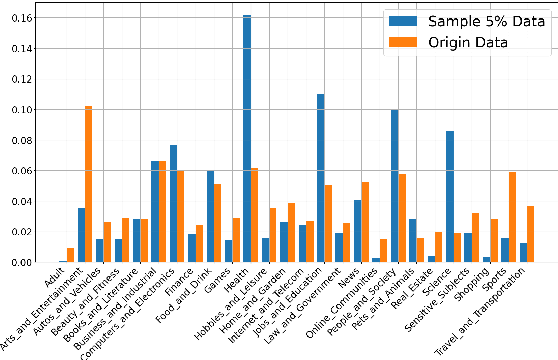
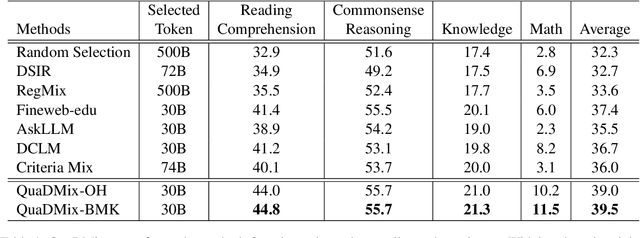
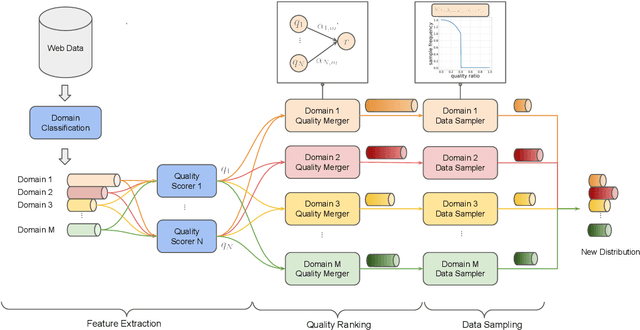

Abstract:Quality and diversity are two critical metrics for the training data of large language models (LLMs), positively impacting performance. Existing studies often optimize these metrics separately, typically by first applying quality filtering and then adjusting data proportions. However, these approaches overlook the inherent trade-off between quality and diversity, necessitating their joint consideration. Given a fixed training quota, it is essential to evaluate both the quality of each data point and its complementary effect on the overall dataset. In this paper, we introduce a unified data selection framework called QuaDMix, which automatically optimizes the data distribution for LLM pretraining while balancing both quality and diversity. Specifically, we first propose multiple criteria to measure data quality and employ domain classification to distinguish data points, thereby measuring overall diversity. QuaDMix then employs a unified parameterized data sampling function that determines the sampling probability of each data point based on these quality and diversity related labels. To accelerate the search for the optimal parameters involved in the QuaDMix framework, we conduct simulated experiments on smaller models and use LightGBM for parameters searching, inspired by the RegMix method. Our experiments across diverse models and datasets demonstrate that QuaDMix achieves an average performance improvement of 7.2% across multiple benchmarks. These results outperform the independent strategies for quality and diversity, highlighting the necessity and ability to balance data quality and diversity.
Advancing Wasserstein Convergence Analysis of Score-Based Models: Insights from Discretization and Second-Order Acceleration
Feb 07, 2025
Abstract:Score-based diffusion models have emerged as powerful tools in generative modeling, yet their theoretical foundations remain underexplored. In this work, we focus on the Wasserstein convergence analysis of score-based diffusion models. Specifically, we investigate the impact of various discretization schemes, including Euler discretization, exponential integrators, and midpoint randomization methods. Our analysis provides a quantitative comparison of these discrete approximations, emphasizing their influence on convergence behavior. Furthermore, we explore scenarios where Hessian information is available and propose an accelerated sampler based on the local linearization method. We demonstrate that this Hessian-based approach achieves faster convergence rates of order $\widetilde{\mathcal{O}}\left(\frac{1}{\varepsilon}\right)$ significantly improving upon the standard rate $\widetilde{\mathcal{O}}\left(\frac{1}{\varepsilon^2}\right)$ of vanilla diffusion models, where $\varepsilon$ denotes the target accuracy.
Muskits-ESPnet: A Comprehensive Toolkit for Singing Voice Synthesis in New Paradigm
Sep 11, 2024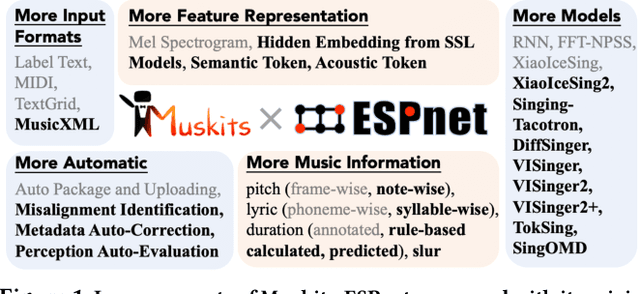

Abstract:This research presents Muskits-ESPnet, a versatile toolkit that introduces new paradigms to Singing Voice Synthesis (SVS) through the application of pretrained audio models in both continuous and discrete approaches. Specifically, we explore discrete representations derived from SSL models and audio codecs and offer significant advantages in versatility and intelligence, supporting multi-format inputs and adaptable data processing workflows for various SVS models. The toolkit features automatic music score error detection and correction, as well as a perception auto-evaluation module to imitate human subjective evaluating scores. Muskits-ESPnet is available at \url{https://github.com/espnet/espnet}.
An Adaptive Tensor-Train Decomposition Approach for Efficient Deep Neural Network Compression
Aug 02, 2024



Abstract:In the field of model compression, choosing an appropriate rank for tensor decomposition is pivotal for balancing model compression rate and efficiency. However, this selection, whether done manually or through optimization-based automatic methods, often increases computational complexity. Manual rank selection lacks efficiency and scalability, often requiring extensive trial-and-error, while optimization-based automatic methods significantly increase the computational burden. To address this, we introduce a novel, automatic, and budget-aware rank selection method for efficient model compression, which employs Layer-Wise Imprinting Quantitation (LWIQ). LWIQ quantifies each layer's significance within a neural network by integrating a proxy classifier. This classifier assesses the layer's impact on overall model performance, allowing for a more informed adjustment of tensor rank. Furthermore, our approach includes a scaling factor to cater to varying computational budget constraints. This budget awareness eliminates the need for repetitive rank recalculations for different budget scenarios. Experimental results on the CIFAR-10 dataset show that our LWIQ improved by 63.2$\%$ in rank search efficiency, and the accuracy only dropped by 0.86$\%$ with 3.2x less model size on the ResNet-56 model as compared to the state-of-the-art proxy-based automatic tensor rank selection method.
VISinger2+: End-to-End Singing Voice Synthesis Augmented by Self-Supervised Learning Representation
Jun 13, 2024



Abstract:Singing Voice Synthesis (SVS) has witnessed significant advancements with the advent of deep learning techniques. However, a significant challenge in SVS is the scarcity of labeled singing voice data, which limits the effectiveness of supervised learning methods. In response to this challenge, this paper introduces a novel approach to enhance the quality of SVS by leveraging unlabeled data from pre-trained self-supervised learning models. Building upon the existing VISinger2 framework, this study integrates additional spectral feature information into the system to enhance its performance. The integration aims to harness the rich acoustic features from the pre-trained models, thereby enriching the synthesis and yielding a more natural and expressive singing voice. Experimental results in various corpora demonstrate the efficacy of this approach in improving the overall quality of synthesized singing voices in both objective and subjective metrics.
Global Well-posedness and Convergence Analysis of Score-based Generative Models via Sharp Lipschitz Estimates
May 25, 2024Abstract:We establish global well-posedness and convergence of the score-based generative models (SGM) under minimal general assumptions of initial data for score estimation. For the smooth case, we start from a Lipschitz bound of the score function with optimal time length. The optimality is validated by an example whose Lipschitz constant of scores is bounded at initial but blows up in finite time. This necessitates the separation of time scales in conventional bounds for non-log-concave distributions. In contrast, our follow up analysis only relies on a local Lipschitz condition and is valid globally in time. This leads to the convergence of numerical scheme without time separation. For the non-smooth case, we show that the optimal Lipschitz bound is O(1/t) in the point-wise sense for distributions supported on a compact, smooth and low-dimensional manifold with boundary.
Singing Voice Data Scaling-up: An Introduction to ACE-Opencpop and KiSing-v2
Jan 31, 2024



Abstract:In singing voice synthesis (SVS), generating singing voices from musical scores faces challenges due to limited data availability, a constraint less common in text-to-speech (TTS). This study proposes a new approach to address this data scarcity. We utilize an existing singing voice synthesizer for data augmentation and apply precise manual tuning to reduce unnatural voice synthesis. Our development of two extensive singing voice corpora, ACE-Opencpop and KiSing-v2, facilitates large-scale, multi-singer voice synthesis. Utilizing pre-trained models derived from these corpora, we achieve notable improvements in voice quality, evident in both in-domain and out-of-domain scenarios. The corpora, pre-trained models, and their related training recipes are publicly available at Muskits-ESPnet (https://github.com/espnet/espnet).
A Systematic Exploration of Joint-training for Singing Voice Synthesis
Aug 05, 2023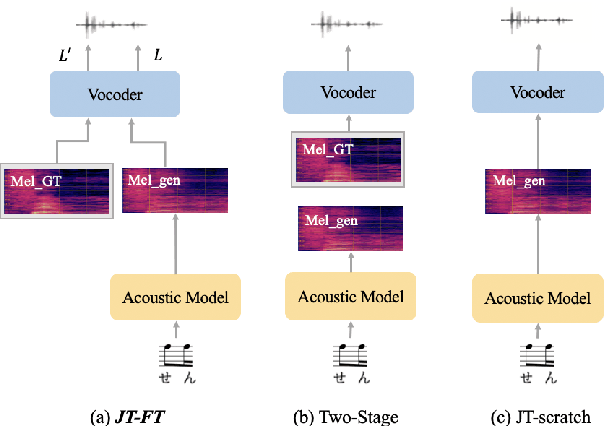

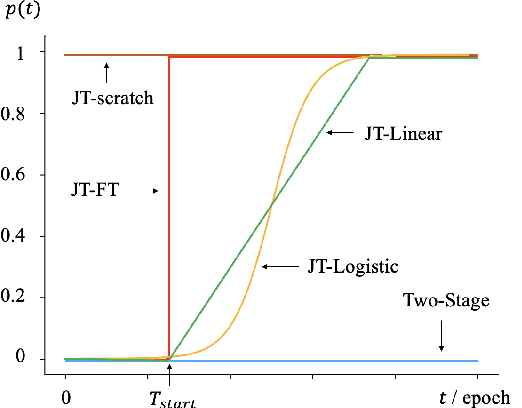

Abstract:There has been a growing interest in using end-to-end acoustic models for singing voice synthesis (SVS). Typically, these models require an additional vocoder to transform the generated acoustic features into the final waveform. However, since the acoustic model and the vocoder are not jointly optimized, a gap can exist between the two models, leading to suboptimal performance. Although a similar problem has been addressed in the TTS systems by joint-training or by replacing acoustic features with a latent representation, adopting corresponding approaches to SVS is not an easy task. How to improve the joint-training of SVS systems has not been well explored. In this paper, we conduct a systematic investigation of how to better perform a joint-training of an acoustic model and a vocoder for SVS. We carry out extensive experiments and demonstrate that our joint-training strategy outperforms baselines, achieving more stable performance across different datasets while also increasing the interpretability of the entire framework.
 Add to Chrome
Add to Chrome Add to Firefox
Add to Firefox Add to Edge
Add to Edge